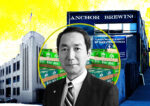Trending
TRD predicts what NYC will look like in 10 years
From skyline wars to building on water, a look at the big real estate projects and trends that may be at the forefront of the industry in a decade
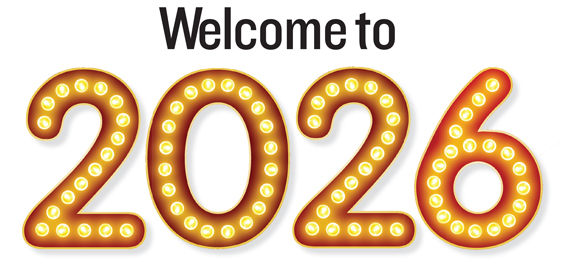
What can happen in 10 years? Well, a decade ago, “Billionaires’ Row” had yet to enter the real estate lexicon. Brokers like Dolly Lenz and Fredrik Eklund weren’t using Twitter to sell high-priced homes. Brooklyn Bridge Park was two years away from construction. And Bill de Blasio was representing a small slice of Brooklyn in the City Council.
Needless to say, New York has changed a lot in the last decade.
And 10 years from now, in 2026, there will undoubtedly be a host of new people, projects, neighborhoods and technologies dominating the conversation.
Who will be the hot developer of the day? Where will the next Billionaires’ Row be? And what project will be capturing headlines?
Looking at the current pipeline of development doesn’t by itself reveal what the New York City real estate industry will be buzzing about in 2026. The kinds of large-scale projects that will reshape the future of the city are likely only in their infancy today — or not on the drawing board at all.
“We’re looking at things that aren’t on peoples’ radar right now,” said Jeremy Shell, the head of acquisitions and finance for TF Cornerstone. “We’re always looking 10 years out. Often that’s the kind of timeline we have to be working with because that’s how long it takes to buy the land, get entitlements, plan it and develop it.”
To be sure, there are myriad factors that will shape New York City development in the next decade, from the fate of the 421a tax abatement program to the proposed Midtown East rezoning. There’s also, of course, political forces at the federal, state and city level. And if history is any indication (hint: it is), any decade-ahead predictions must factor in the likelihood of another economic recession.
This month, The Real Deal looked at some of the big issues that experts think could be at the forefront of the industry in 2026.
In the skyline wars, East Midtown strikes back
With office construction surging at Hudson Yards and the World Trade Center, the Far West Side and Lower Manhattan have recently grabbed momentum from Midtown East, where the office stock is primarily made up of older, albeit classic, buildings.
But by 2026, all that could change as the city pushes a proposal, started under the Bloomberg administration, to rezone a 73-block area bordered by Fifth and Second avenues between East 39th and East 57th streets. It may be hard to imagine given all of the false starts, but when the plan (finally) gets approved — and observers say it’s inevitable given the area’s aged office supply — Midtown East will be a hotbed of new office development.
Under the proposed rezoning, large areas around Grand Central Terminal could be granted greater density, paving the way for developers to build soaring skyscrapers. The latest plan also calls for owners who want to construct bigger projects to contribute toward transit-related upgrades.
The city has already given the green light to SL Green to develop the 1-million-square-foot One Vanderbilt, which when completed by 2020 will rise 1,500 feet and be the tallest tower in the neighborhood since the Chrysler Building topped out at 1,050 feet in 1930.
Even more critically perhaps, sources say a rezoning could create competition that would encourage owners of existing buildings to upgrade.
“There are architecturally distinctive buildings of 1 million square feet or more that deserve to be repopulated in the 21st century but need an infrastructural overhaul,” said Michael Cohen, president of commercial brokerage Colliers International tri-state operations. “Some buildings are air conditioned with one on/off switch. Somebody needs to come up with a way to replace these buildings’ HVAC plans with more energy efficiency and a more tenant-controlled environmental system.
“That day of reckoning is coming,” he added.
Brooklyn will become a bona fide tech hub
Developers and city officials have been beating the tech drum for some time now, with several studies pointing to tech as the hottest sector in the city’s economy, unseating Wall Street.
From 2009 to 2013, employment in New York City’s tech sector grew by 33 percent, according to a study by the state comptroller. And as of the third quarter of 2015, New York pulled in more than $5.6 billion in venture capital, the highest since 2000.
While the tech industry is undoubtedly taking root now in Lower Manhattan and parts of Brooklyn and Queens, in 10 years it should be in full bloom.
And if Brooklyn developers have their way, their borough will be the only logical choice for techies (see related story on page 44).
From Williamsburg and Greenpoint in the north to Sunset Park in the southern part of the borough, Brooklyn has some 48 million square feet of office space, making it the sixth-largest office market in the nation, behind Atlanta and San Francisco, according to an October CBRE report. The borough has more than 8.5 million square feet of either new development or major repositionings in the pipeline over the next few years.
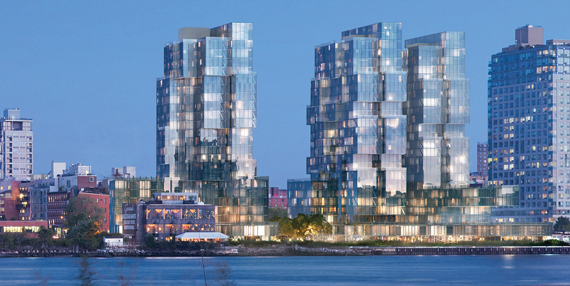
A rendering of the trio of buildings that former New York Governor Eliot Spitzer is planning in Williamsburg (credit: ODA New York)
They include projects aimed at tech tenants, like the renovation of the Brooklyn Navy Yard’s hulking, 960,000-square-foot Building 77; Boston Properties and Rudin Management’s 675,000-square-foot development dubbed Dock 72; Est4te Four’s plan for its 1.1-million-square-foot, mixed-use Innovation Studios in Red Hook; Midtown Equities’ warehouse redevelopment at Empire Stores in Dumbo; and Kushner Companies, RFR Realty and LIVWRK’s renovation of the Jehovah ‘s Witness Watchtower complex.
In addition, Heritage Equity Partner is developing Brooklyn’s first speculative office building in decades: a 400,000-square-foot office at 25 Kent Avenue in Williamsburg.
These new projects will fill a crucial void of Class A office space in Brooklyn. But some say they will also lay the groundwork for future towers that could put Brooklyn on the commercial market map in an even bigger way.
“We’ve yet to see the advent of a 21st century commercial high-rise building in Brooklyn,” said Forest City Ratner president MaryAnne Gilmartin. “I think that’s going to be a thing of the past. Brooklyn’s going to have the ability by 2026 to have a go-to headquarters location.”
What kind of company does she expect? “A media company or technology company — a huge consumer of talent with a really, really strong brand,” Gilmartin predicted.
Manhattanites will ogle at waterfronts across the river
Since development along the Brooklyn and Queens waterfront kicked off with force over the past decade, neighborhoods like Long Island City and Williamsburg have added about 15 high-rise apartment buildings along the East River.
But in the next decade, expect the outer borough skyline to move to the next level: At least eight megaprojects planned up and down the waterfront from Mott Haven in the Bronx to Williamsburg could bring more than 30 new buildings, with some 18,000 residential units.
“When you look at Manhattan and then you look across the waterfront into the boroughs, you will see high rises stretch from the Bronx [down into Brooklyn],” said Robin Schneiderman, head of new business at Halstead Property’s new-development marketing group. “It’s going to be basically a line of buildings.”
Chief among the megaprojects is Greenpoint Landing, where partners Park Tower Group and L&M Development broke ground last summer on the first of 10 buildings. The 22-acre site will be home to some 5,500 apartments when it’s completed, sometime between 2024 and 2026.
Two Trees has already broken ground on a 16-story apartment building on the Williamsburg waterfront, the first of four mixed-use buildings at the former home of the Domino Sugar Factory. By 2026, the site should have 2,300 apartments and about 500,000 square feet of commercial space.
Meanwhile, former-governor-turned-developer Eliot Spitzer is planning to make a big architectural splash with a trio of buildings in Williamsburg that will stand 24 stories and have 856 apartments — plus two rooftop pools. The project’s architect, Eran Chen, founder of ODA New York, has described the boxy, futuristic triplets as a “molded iceberg, sculpted to create the maximum number of views and outdoor spaces.”
Long Island City, which has already sprouted the most significant skyline in Queens, will see its landscape of towers expand further yet. Work is underway on the second phase of Hunters Point South, a 30-acre waterfront megaproject set to bring 5,000 units and an 11-acre park.
Nearby, in Astoria, along the East River, the Durst Organization is planning a seven-building, 2,400-unit complex called Hallets Point, while Alma Realty’s Astoria Cove development is set to deliver 1,700 apartments.
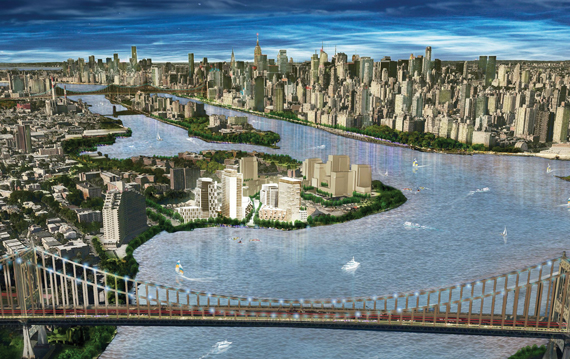
A rendering of the Durst Organization’s Hallets Point project in Astoria
And just south of the Queensboro Bridge, Silvercup Properties is currently trying to resurrect the long-discussed $1 billion megaproject Silvercup West. The mixed-use plan, which calls for 1,000 residential units and eight new soundstages for Silvercup Studios, was initially supposed to break ground in 2008 but stalled amid the recession. In late 2014, the landowner cleared the first hurdle to getting the project back on track after the local community board approved an application to renew a special permit for the site.
New Yorkers will have more reasons not to drive
Transportation projects typically have long horizons. The Second Avenue Subway, for example, is now projected to open in late 2016 — roughly 100 years after first being proposed.
But there is a slew of key transportation projects either underway or being discussed that could revolutionize the way New Yorkers get around the city by 2026.
Straphangers should finally see the Metropolitan Transportation Authority’s long-awaited “East Side access project” come to fruition. That project will bring the Long Island Rail Road — which currently terminates at Penn Station — into Grand Central, providing a major boon for Long Islanders who commute into the city. It is set to be completed in 2022.
The MTA is also looking to build four new commuter-rail stations in the Bronx, at Co-op City, Morris Park, Parkchester and Hunts Point — all of which is expected to spur development.
The RPA’s Richard Barone said developing these areas is a financial opportunity for both the MTA and the real estate industry. “[The MTA] can actually monetize whatever it has to make it possible for developers and communities to develop those assets,” he said.
And although 10 years might be a conservative estimate on what has been a fractious political issue, it’s reasonable to assume that the $20 billion Hudson River tunnel might be within sight by then. The plan, which is designed to relieve a critical bottleneck between New York and New Jersey, received a boost after the latest federal transportation bill made it easier for Amtrak to access funding.
In addition, by 2026 more New Yorkers — at least those who aren’t hailing Ubers — will take to the city’s waterways. Although Bloomberg introduced an East River ferry service between parts of Manhattan, Brooklyn and Queens in 2011, Mayor Bill de Blasio is expanding it in 2017. Routes will initially open along Astoria, South Brooklyn and the Rockaways. The following year, additional stops will be added in the Lower East Side and Soundview in the Bronx.
Other projects that are being talked about and could be in the works 10 years from now include a street car along the Brooklyn-Queens Waterfront and an outer borough subway line running from Sunset Park to Hunts Point in the Bronx.
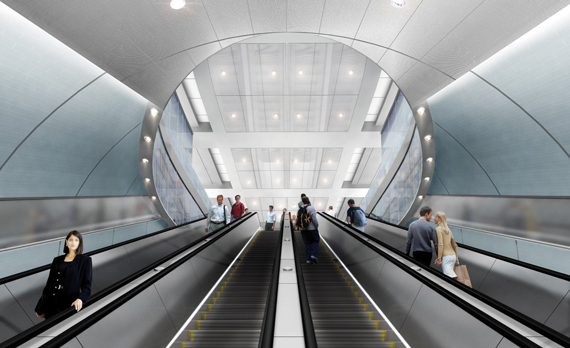
The LIRR Station at Grand Central is scheduled to be completed in 2022.
Finally, if all of the above doesn’t sound revolutionary enough, Nick Romito, founder of the cloud-based leasing-management startup View the Space, said he thinks Google’s plan to put a driverless car on the road within the next few years will impact real estate in a “huge way.”
“I have a theory that the amount of potential real estate in New York City is going to expand,” he said, arguing that driverless cars would be free to park farther away, thus freeing up prime real estate currently used for parking. “I think there’s no chance we’re going to have parking garages in the middle of cities.”
Parks will be like the ‘High Line on steroids’
Who doesn’t love a good park? If the decade that brought us the High Line and Brooklyn Bridge Park taught us anything, it’s that New Yorkers love urban oases.
Over the next 10 years, New York could be well on its way to the Bloomberg administration’s goal of putting a park within a 10-minute walk of every resident by 2030. The parks department has several hundred new construction and renovation projects in the works and earlier this year boosted its staffing levels to speed up timelines.
It’s more than just a laudable health goal. More parks can mean more green for real estate. In West Chelsea, property values near the High Line increased 103 percent between 2003 and 2011, according to the city.
Here’s a brief history lesson: The city’s current green space is the result of three “Great Ages” of park development. The first (think Fredrick Law Olmstead and Calvert Vaux) gave us Central, Prospect and Riverside parks. The second (the age of Robert Moses) gave us Jones Beach State Park among some 20,000 other green acres.
The third began in the early aughts and produced the aforementioned High Line and Brooklyn Bridge Park. That model of reclaiming infrastructure or defunct waterfront space has inspired similar projects, including the so-called “Low Line,” an abandoned underground rail tunnel on the Lower East Side and the Queens Way, the proposed reclamation of unused tracks some 3.5 miles long.
“It’s like the High Line on steroids,” said Adrian Benepe, NYC’s former parks commissioner who now works at the national nonprofit Trust for Public Land, referring to the Queens project.
Benepe said the biggest boon to parks could come as a result of private development along the waterfront, which since the early 1990s has been required to incorporate open public space.
“People often say we have to reopen the waterfront. The New York City waterfront was never open to recreation. It was totally devoted to commerce, especially in Manhattan.”
NYC’s next prime projects could be on the water
To be sure, constructing on water is nothing new.
In the 1980s, the Related Companies had plans to build a mixed-used complex dubbed River Walk over the East River. But the project fell apart after the developer’s financial partner, Cadillac Fairview, backed out.
And Battery Park City, of course, sits on 92 acres of landfill at the southern tip of Manhattan.
But developers are increasingly turning toward the water for new and potentially game-changing projects. Ten years from now, the city’s piers could be redeveloped for all kinds of uses.
Google, which has a 1-million-square-foot campus in the Meatpacking District, is already planning to move some 1,000 employees to a new 250,000-square-foot home over the Hudson River at Pier 57. The so-called Super Pier, being developed by RXR Realty and Youngwoo Associates, is set to open in 2018 and will also feature a 150,000-square-foot food hall curated by celebrity chef Anthony Bourdain.
Meanwhile, billionaire media mogul Barry Diller wants to build a park floating on piers over the Hudson River. And last year, in Battery Park City, restaurateurs Danny McDonald and Peter Pulakakos opened a massive food hall at Pier A on top of an old 19th-century dock the Dermot Company leased in 2011 from the Battery Park City Authority for 25 years.
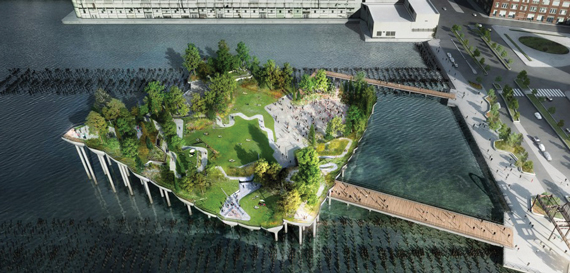
A rendering of Barry Dillet’s floating park he wants to build on piers over the Hudson River
“Whether it’s on piers or adjacent to piers, I think you’ll see more deals on the waterfront,” said Jay Neveloff, a partner at the law firm Kramer Levin Naftalis & Frankel. He said his clients are increasingly more willing to take on the kinds of complicated deal structures needed to build on the water.
“It’s an amazing asset,” he added. “I’m always amazed there isn’t as much on the water here in the city.”
Gary Barnett will lead another nabe makeover
Ten years ago, few could have predicted that 57th Street would become Billionaires’ Row, with gleaming towers serving as bank vaults to the super rich, starting with Extell Development’s One57.
With that in mind, TRD is going to go out on a limb and say that since Extell’s Gary Barnett seems to have the gift of foresight, his newest condo tower at the base of the Brooklyn Bridge will be the first in a number of towers that will transform the formerly gritty Lower East Side neighborhood known as Two Bridges into the next luxury locale.
There are other projects worth mentioning in the neighborhood, most notably the 1.9-million-square-foot mixed-use development a few blocks north at Essex Crossing.
But Barnett’s One Manhattan Square at 250 South Street is expected to tower above the competition, rising 56 stories with 646 apartments that the company is marketing to buyers from China, Malaysia and Singapore. Suggesting the market’s new sweet spot, the units will be priced between $1 million and $3 million.
With tongue in cheek, we predict that Harry Macklowe, Vornado Realty Trust, the Zeckendorfs and JDS Development will follow in Barnett’s footsteps, and in 10 years the base of the Brooklyn Bridge will be lined with luxe towers.



